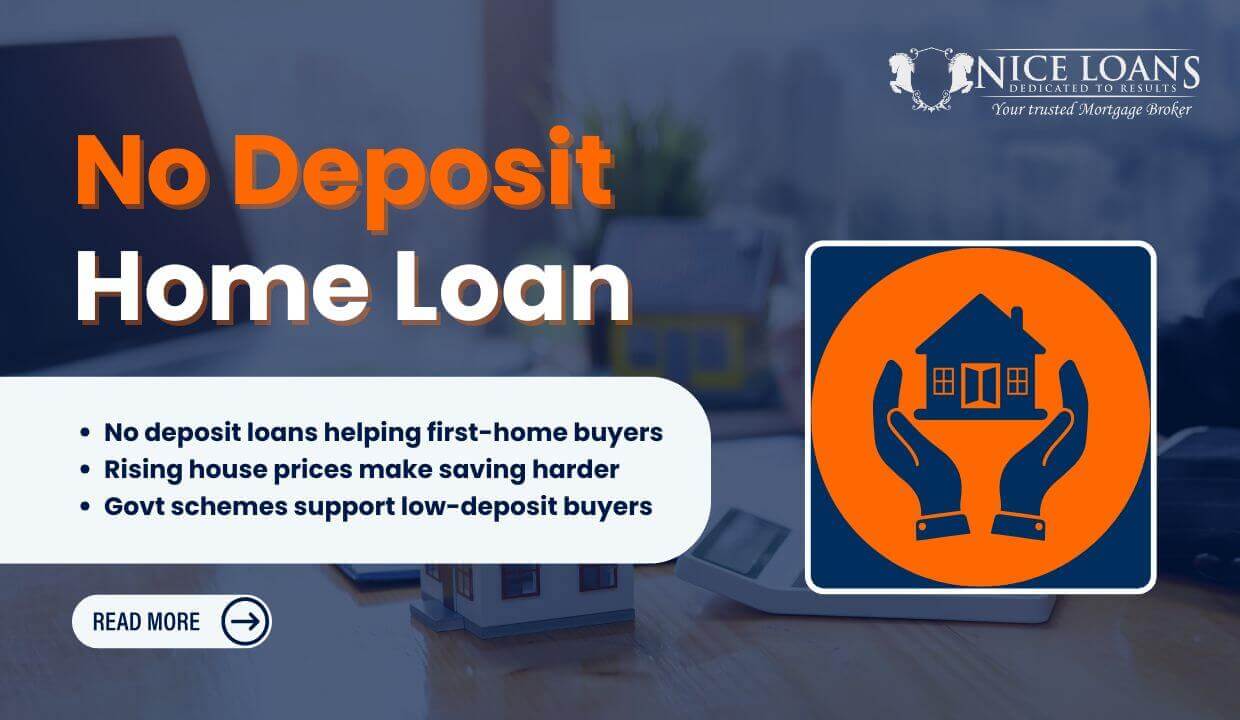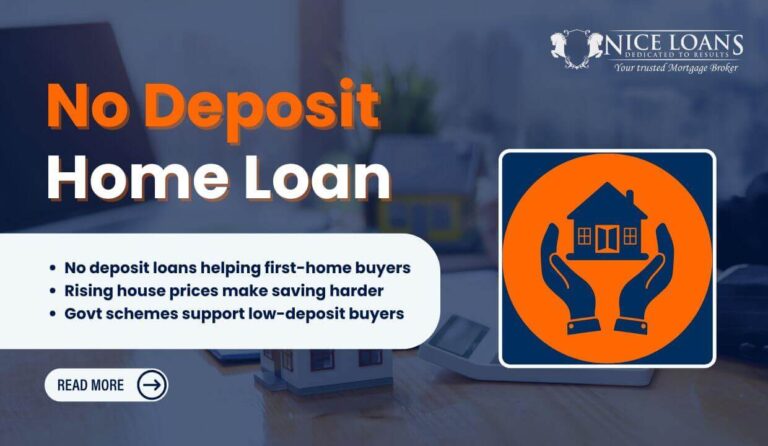Buying your first home is exciting but also stressful, especially when you don’t have a deposit. The Australian property market has seen the value of homes keep rising, making it harder for first-time buyers to move forward. Accumulating 20% of the deposit plus bills, rent, and living expenses feels like a mission impossible to everyone. It is here that the notion of no-deposit home loans is not only beneficial but also life-changing.
These loans are designed to reduce the single biggest hurdle to home ownership: the deposit. Instead of taking decades to save tens of thousands of dollars, you can purchase your first home with no or little deposit. Either through the help of a family guarantor, a government scheme, or low-deposit offers from lenders, there are ways of getting into the property market sooner than you think.
But is it as simple as it sounds? And most importantly, is it ideal for your financial future? In this guide, we detail what no-deposit home loans really are, how they work in Australia, and what’s on offer to first-time homebuyers to help take the plunge. From eligibility criteria to the pros and cons, you’ll get a clear picture of how to buy your first home, even if your bank account isn’t quite ready.
What Is a No Deposit Home Loan?
A no-deposit home loan is a mortgage that allows you to buy a home without having to produce a deposit from your own funds. Instead of having to save 5%, 10%, or 20% of the house value, you get to borrow 100% of the home value. For the majority of first-home buyers, this can be a considerable advantage, especially if saving for a deposit appears like something that is utterly out of reach.
On a standard home loan, the lenders want you to make some contribution towards the initial outlay. This deposit acts as a cushion against the possibility of the value of the real estate dropping or your failure to service the repayments. It is also a sign that you are serious and have money. On a zero-deposit mortgage, there is no cushion. Due to this, the lenders pull in their horses before the home loan is approved.
To be eligible for a no-deposit home loan, you need to prove that you’re financially capable. The financiers will look at your credit history, employment history, monthly spending, and loan suitability. They’ll also look at how well you manage money, whether there has been any default in payments, and whether you have a good financial record. Good borrowing capacity and minimal debt will work in your favour.
Fewer lenders will advance a no-deposit home loan without assistance or security of some form. This could be:
- A guarantor, usually a parent or family member, is prepared to guarantee your loan by using the equity in their home.
- A government program, like the First Home Guarantee Scheme, offers a partial guarantee on your loan so you don’t have to pay Lenders Mortgage Insurance (LMI).
- A gifted deposit is when a close relative gifts you the deposit value with no chance of it ever being paid back.
Even if you’re not paying the deposit yourself, it doesn’t mean there’s no cost involved. You’ll still have to include repayments on the loan, stamp duty, legal fees, and other home-buying expenses anyway. In some cases, lenders may even charge higher interest fees you’ll be paying or ask you to pay LMI unless you just so happen to qualify for an exemption under a government-insured scheme.
Can You Buy a House Without a Deposit?
The simple answer is yes. You can get a “No-Deposit home loan” when you purchase a house. But it’s not always easy. The vast majority of people doing this need assistance from family or through government programs.
Lenders are careful. They want assurances that they’ll be made whole. Without a deposit, they’ll need you to prove you’re still a low-risk borrower. That might be a solid history of saving, a stable salary, or additional security such as a guarantor.
A no-deposit mortgage without a deposit is difficult to come by but can be obtained through the proper channels.
How to Get a Home Loan with No Deposit?
Now, let’s take a look at how you can actually get a no-deposit home loan. In Australia, here are your four broad options:
Use a Guarantor
The most common way to find a mortgage with no deposit is to use a guarantor. Typically, a guarantor is a close family member. They secure your loan with their own property. If you stop paying, the lender could prompt them to pay your debt.
These loans are attractive to lenders as they avoid risk. They might agree to advance your loan eligibility even though you have no savings. But be sure your guarantor knows the risks.
First Home Guarantee Scheme
The Australian Government manages the First Home Guarantee program. It allows first-time buyers to purchase a house with a mere 5% deposit. The government covers the rest so that you won’t need a guarantor, and you won’t have to pay Lenders’ Mortgage Insurance (LMI).
This plan is not available to any buyer. You have to have sweat equity, live in the home, and not own any other property. It’s a nice way to make a purchase with a small deposit and avoid additional costs.
Gifts From Family
Or if a family member, such as your parents, gives you a deposit as a gift, that might work, too. Some lenders will accept this as evidence of savings. But they might request a letter confirming that it is a gift, not a loan.
Use Your Superannuation
Use voluntary super contributions to purchase your first home with the First Home Super Saver Scheme. Up to $50,000 can be withdrawn and put toward your deposit. This is not a no-deposit loan on its own, but it does help you save more quickly and purchase more quickly.
Advantages and Disadvantages of No Deposit Home Loans
A house loan without a deposit has pros and cons. It is important to understand both before you apply.
Pros:
- Buy Sooner: A home doesn’t have to be years away.
- No More Rent: You no longer need to pay rent, but you can be building equity.
- Access to Grants: You can combine no-deposit loans with government assistance.
Cons:
- Bigger Loan Amount: You take out a larger loan, resulting inf higher loan repayments.
- More Risk: The longer you are in debt, the more you pay in interest.
- Risk of Negative Equity: If property prices fall, your loan could exceed the home’s worth.
- Guarantor Risk: Default, and they potentially lose a portion of their property.
Before applying, you should speak to a mortgage lender or financial advisor. They can help you understand the risks involved and your eligibility for a loan.
What Lenders Look For
Even if you don’t have to put a deposit down, lenders check a lot of stuff before handing you the home loan. Here’s what they look at:
- Credit score: A good score indicates that you pay your bills on time.
- Past Employment History: A stable job history is better than a work history of short-term jobs.
- Income: You have to make enough to cover repayments and living expenses.
- Expenses: Lenders are concerned with your spending habits, your debts, and your savings.
- Repayment History: They like to see that you’ve paid previous loans responsibly.
Some lenders might promote better rates or waive some fees if you have a good profile.
Low to No Deposit Loan Alternatives
No-deposit loans aren’t available to everyone. But there are other ways to purchase your first home:
Low Deposit Loans
Some banks will lend you the money for only a 5% or 10% deposit. No-deposit loans, especially mortgage loans, are much harder to access than debt consolidation loans. But you may need to pay LMI.
Rent-to-Buy Options
In this model, you lease a home, and a portion of your rent contributes to a future buy. Such agreements let you live in the property while you save a deposit. However, they are uncommon and require legal counsel.
Shared Equity Schemes
In some state governments, there’s shared ownership. You purchase a portion of the property and pay rent on the remainder. You can buy a more significant share later.
First Home Owner Grant
This is a payment to help first-time buyers. How much depends on where you live. It may also be utilised to lower your loan amount or to cover additional expenses.
Tips for First-Time Homebuyers
- Know Your Borrowing Power: Use the online calculators to get an estimate.
- Talk to a Broker: A mortgage broker may be able to help you find lenders who accept no-deposit or low-deposit loans.
- Build Good Credit: Pay bills on time and pay down debts.
- Plan Your Budget: Once you buy a home, your spending will shift.
- Account for Added Expenses: Remember stamp duty, legal fees, and moving costs.
Good planning can make homeownership more achievable, even if you don’t have savings for a deposit.
Final Thoughts
In Australia, a no-deposit home loan may help aspiring first-home purchasers move into their new abode sooner. It eliminates the most challenging part of purchasing a house: building up a large deposit. But it also comes with risks. You take on more debt and then face stricter checks, and you may have to get a guarantor involved.
Consider all your options before getting onto this path. Research government schemes, converse with lenders, and consult authorities. With wise planning, it is possible for you to own your first home, even without a deposit.








